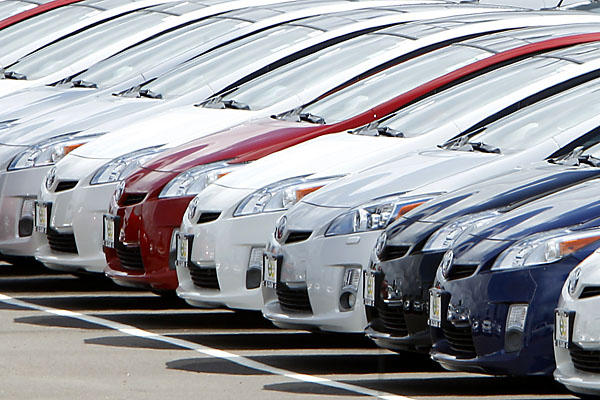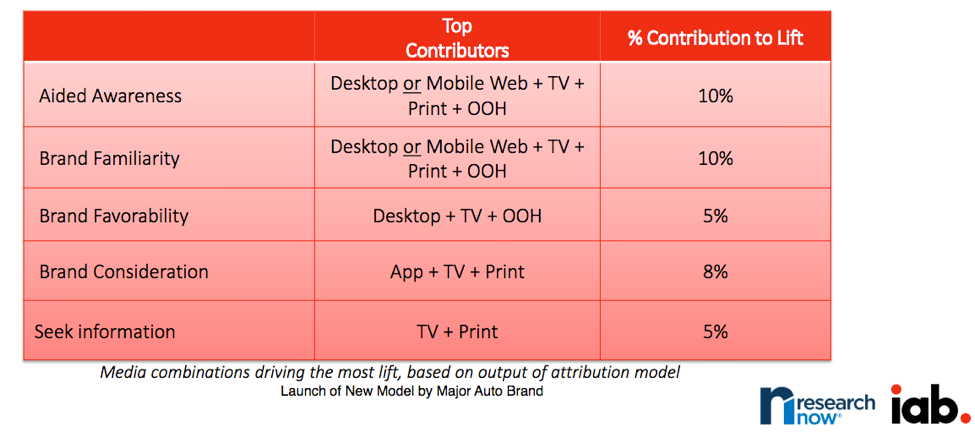
The Interactive Advertising Bureau, with Research Now, released a study last Friday that explores marketing lift from combinations of traditional and digital channels. The controlled study examined brand recognition and recall in two markets, for a new automobile among men with household incomes of at least $75,000 and for a new consumer packaged goods product among Millennial and Gen X women from ages 18 to 49. In both studies, but especially among men considering an auto purchase, blended traditional and digital campaigns improved brand recognition and favorability.
In this post, we’ll apply their findings to the Los Angeles automotive advertising market to illustrate the potential returns from the combinations of media identified by IAB. In recent postings, here and here, we’ve investigated the LA auto market, the second largest in the nation, and we’ll return to that data again here.
The headline is that IAB and Research Now report the combination of traditional (print, TV, radio, and cable) is better combined with digital advertising than when used alone. IAB reported that among men considering a new model automobile, digital desktop advertising produced an 11.2 point lift (22 percent) in brand familiarity. Mobile web ads and app advertising improved brand familiarity by 9.4 points (18 percent) and 8.2 points (16 percent), respectively. Interestingly, mobile does not produce the same improvements as desktop ads, the IAB study said.
The combination of TV, desktop, and mobile ads produced the biggest increase in unaided brand awareness of these male auto shoppers, 19 points (211 percent). The aggregate lift by marketing goal and media blend are described in Figure 1.
Figure 1: The Best Channel Combinations Typically Include Digital and TV
 As we pointed out earlier this month, the spending within a market can be highly variable. Spend per channel varies widely by geographic market, vertical market, and channel, based on local media preferences and anecdotally “proven” budget mixes established before data became available. The IAB guidance is an excellent basis for understanding the importance of the ad mix, but it doesn’t provide rules marketers can apply generically.
As we pointed out earlier this month, the spending within a market can be highly variable. Spend per channel varies widely by geographic market, vertical market, and channel, based on local media preferences and anecdotally “proven” budget mixes established before data became available. The IAB guidance is an excellent basis for understanding the importance of the ad mix, but it doesn’t provide rules marketers can apply generically.
Comparing Los Angeles to New York, the largest automotive advertising market, for example, BIA/Kelsey’s Local Ad View database shows that TV plays a much larger role in L.A. (see Figure 2) Automobile dealers and manufacturers in Los Angeles focus 42 percent of spend in television compared to 32.05 percent in the Big Apple.
Figure 2: Los Angeles Automotive Dealer and Manufacturer Local Media Spend, by Channel in 2016
Online display advertising is more important in New York than L.A., where radio is the third most-used channel for auto advertising, accounting for 11.43 percent of L.A. budgets and nine percent of New York City spending. Likewise, direct mail is used ten times more, as a share of total spending in New York than L.A. Despite eternal predictions of doom, print news in New York holds onto the third spot among all channels while Los Angeles’ driver-centric consumers see 2.50 percent less spending on print news by auto advertisers.
We advise clients and advertisers to examine local spending data carefully to find the best combinations of traditional and digital channels. The Los Angeles example shows clearly that the best brand aided awareness results – combining desktop or mobile digital plus TV plus Print plus OOH – can be achieved with several different media mixes by selecting judiciously from different types of online inventory.
 Some inventory may cost less or be less dominant in a market because marketers have applied only rules of thumb instead of deep analysis to achieving the best ROI. From market to market, as the New York examples demonstrate, Los Angeles advertisers could spend less on online display than their Eastern counterparts to achieve a better overall lift by concentrating on the less competitive online news inventory in L.A.
Some inventory may cost less or be less dominant in a market because marketers have applied only rules of thumb instead of deep analysis to achieving the best ROI. From market to market, as the New York examples demonstrate, Los Angeles advertisers could spend less on online display than their Eastern counterparts to achieve a better overall lift by concentrating on the less competitive online news inventory in L.A.
Television is an excellent channel for raising brand awareness, but it can be problematic as a channel for product details. This is why the combination of TV and digital can be so powerful. Digital provides follow-on engagement that can support extensive product information, as well as more narrative about the customer experience.
The IAB data shows that TV is a core investment in any local marketing effort, but the blends of TV and digital are wide-ranging and must vary by market. Study your available inventory carefully before deciding on the right combination punch.

This Post Has 0 Comments